#New York hot dogs
Explore tagged Tumblr posts
Text

Let’s hear it for New York, New York! The city that never sleeps, where the streets will make you feel brand new and big lights will inspire you. You won’t go hungry in New York either, as taking a bite out of the Big Apple has always been easy. The city has long been celebrated as one of the great culinary capitals of the world and is well-known for its diversity of iconic foods. But you don’t have to head into the heart of Manhattan to indulge in classic New York treats when you can easily source them at your local Down to Earth farmers market this weekend.
Your Best B.E.C. The B.E.C., which stands for bacon, egg and cheese, is a favorite New York way to start the day. This salty, savory breakfast combo can be ordered at every deli, corner store and bodega throughout the big city and its boroughs. The belly-filling sammy is most often served on a plain or poppy seed roll or bagel and comes wrapped in foil.
The B.E.C.’s origins can be traced back to the Industrial Revolution of the 1800s, when British street vendors sold egg and meat sandwiches on soft rolls to factory workers who needed a quick and hearty meal before their long work shifts. As factories began to appear in the United States, the breakfast sandwich crossed the Atlantic and quickly became a much-cherished New York ritual.
Skip the line at the deli counter this weekend and elevate your B.E.C. recipe with top-of-the-line, locally produced ingredients from the farmers market:
2 rashers Goode and Local By Don Rodrigo Mangalitsa Hickory Smoked Bacon
2 Great Joy Family Farm, SOVA Farms or Stone & Thistle Farm pastured eggs
1 Badass Bagels plain or poppy seed bagel
3 tablespoons Maplebrook Farm or SOVA Farms butter
Plain McGrath Cheese Company cheese curds
Salt and freshly ground pepper to taste
Optional: Simple Fine Foods Spicy Chipotle Squeeze
Coffee…Regular Any self-respecting New Yorker washes down their B.E.C. sandwich with a piping cup of “regular coffee” as an essential part of breakfast. A regular coffee in New York means a short coffee with milk and two sugars. It’s the default coffee of the city because it’s easy to make and quick to order, which best suits the fast pace of life in the concrete metropolis.
Pick up a hot cup of regular coffee from Cano Coffee Company to sip as you stroll through the market. Cano Coffee Company is a New York-based roaster that imports beans from their family coffee estate in Colombia. Their range includes ground and whole bean bold, medium and mild roasts, kcups, and growlers of cold brew.
Slice, Slice Baby Iconic New York-style pizza began when Gennaro Lombardi, an Italian immigrant from Naples, opened the country’s first pizzeria in Manhattan’s Little Italy neighborhood in 1905 serving large, wide pies. The quintessential New York pizza has a thin crust that is foldable yet crispy and is traditionally topped with tomato sauce and mozzarella cheese, with any extra toppings placed on top of the cheese.
Enjoy a slice of New York with Wave Hill Breads’ artisanal pizzas that are parbaked for easy prep. Simply remove the plastic wrap and pop them in the oven at 450 degrees for 12-15 minutes and enjoy:
Margherita: Italian tomatoes, mozzarella, grana podano, basil
Quattro Formaggi: Mozzarella, gorgonzola, asiago, pecorino romano
Zucca e Limone: Zucchini, mozzarella, grana adano, basil pistou, lemon zest
Salsicia: Italian sweet sausage, sweet onions, roasted peppers
Veggie: Yukon gold potatoes, rosemary, garlic, mozzarella, green onions
In a Pickle? New York City was destined to become the “pickle capital” of the United States after Dutch farmers began growing cucumbers in Brooklyn in 1659. These settlers pickled the cucumbers and sold them from barrels on the street. Without modern refrigeration, pickles provided the early colonists a way to eat veggies during the barren winter months when there wasn’t much else available. When a heavy influx of Eastern European Jews arrived during the late 1800s and early 1900s, they introduced their pickling traditions, along with kosher dill pickles, to New York City.
Get into the New York spirit with a pickle-on-a-stick or a whole container of tangy, briny pickles from Dr. Pickle. The Nadel brothers of Dr. Pickle grew up doing every step of the pickle business while working for their father. Now a third-generation company, they’ve always created their products as naturally as possible, often sourcing from local farms in New York and New Jersey. And while the generations may change, the time-soaked recipes do not.
The Big Oyster When Henry Hudson sailed into New York Harbor, there were miles of oyster reefs stretching in every direction that supported up to half of the world’s oyster population. Huge, plump oysters growing up to 10 inches long could be easily plucked out of the water and eaten fresh like fruit off the vine.
For an entire century, the port of New York was known as the oyster capital of the world, with millions of discarded shells used to pave its roads and make mortar and lime to fuel the city’s building boom. Unfortunately, unsustainable consumption, habitat destruction and sewage pollution decimated wild oyster populations, with the last New York City oyster bed closed for harvesting in 1927. Today, oysters harvested from the coast of Long Island Sound are considered some of the best in the world. Blue Point Oysters are the most famous local variety and have been a fixture on New York City restaurant menus since the early 1800s.
Get your shucking knife sharpened and ready for action and stop by American Pride Seafood to scoop up some freshly harvested Blue Points. The world may be your oyster, but there’s nothing quite like a full-blown, over-the-top New York-style shellfish extravaganza!
Who Let the Dogs Out? Hot dogs are one of the most famous street foods in New York City, with New Yorkers consuming more hot dogs than any other demographic in the country. The classic New York dog is served inside a soft bun with steamed onions and a pale yellow, deli-style mustard.
You don’t have to settle for a ho-hum hot dog when Goode and Local By Don Rodrigo is cooking up their delicious Smoked Bacon Cheddar Sausages onsite at the market! These mouth-watering Mangalitsa pork bratwursts are served on a potato roll with generous toppings of tangy Hungarian sauerkraut and Goode and Local’s very own chili.
Think you need to schlep somewhere for real NYC food? Fuhgeddaboudit! Just head directly to your Down to Earth farmers market this weekend for the freshest, locally sourced and tastiest iconic New York treats. We look forward to seeing you there!
#downtoearthmkts#farmersmarket#farmersmarkets#eatlocal#buylocal#shoplocal#eatdowntoearth#local food#new york foods#iconic new york foods#pickles#new york pizza#New York pickles#New York hot dogs
0 notes
Text

DMX “Its Dark And Hell Is Hot” Era “Get At Me Dog”
#realnyhiphop101#nyc#real hip hop#Dmx#it’s dark and hell is hot#new york#real ny hip hop 101#Get at me dog#Def jam#ruff ryders#yonkers ny
167 notes
·
View notes
Text

297 notes
·
View notes
Text

Shoeshine boys having lunch, 1947.
Photo: Stanley Kubrick via Twisted Sifter
#vintage New York#1940s#Stanley Kubrick#shoeshine#shoeshine boys#Sabrett cart#hot dogs#hot dog vendor#1940s New York#child labor#hot dog cart#vintage NYC
131 notes
·
View notes
Text








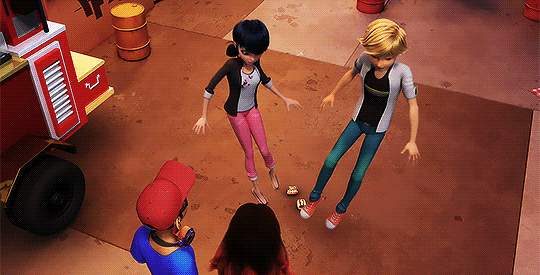

Hot Dogs
#miraculous ladybug#mledit#miraculousedit#animationedit#hot dog dan#nino lahiffe#alya cesaire#marinette dupain cheng#adrien agreste#miraculeakless#ml leak free#mine#ep: new york#project: ot4
536 notes
·
View notes
Text

sorry i had to glaze this glizzy
what a world ;_;
but ;) he'll be a sticker at New York Comic Con ~
#nycc#nycc 2024#new york comic con#hot dog#weiner dog#dog#dachshund#sticker#stickers#sticker art#sticker design
45 notes
·
View notes
Text
Ray’s Candy Store, NYC
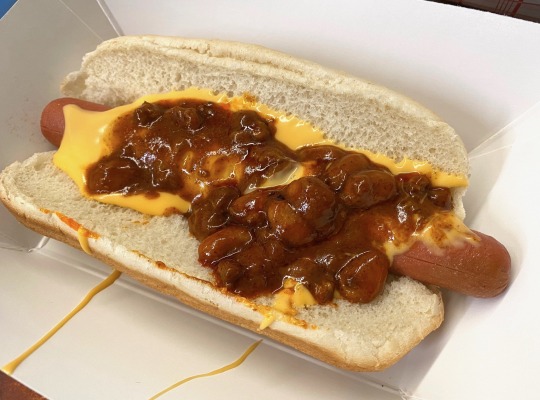
I’m posting about Ray’s Candy Store today as it’s been in the news this week, but for unfortunate reasons, as the owner, 90 year old Ray Alvarez, was beaten in his own shop. The local legend suffered bruising to his face in the attack, but thankfully, police quickly apprehended the offenders. Ray is now back at work to the delight of the neighborhood!

Ray’s is a fixture in the East Village, and as notorious eater of chili cheese dogs, we’ve frequented the place ever since we moved downtown.
As the name implies, Ray’s is known for its sweets and snacks, but savory noshes are available as well. His egg creams, soft serve and beignets are also rather famous...

Ray runs the counter by himself, preferring to sell classic New York boiled dogs made in a crockput...

The homemade chili is a meat and bean blend and the cheese is whiz...

For $2.50, it’s better than any hot dog you can find on the street!
When and if you go, do try and spend some time inside the cramped counter and look around, as Ray’s has been there since 1974 and is filled with eclectic pieces of New York history.
RAY’S CANDY STORE
113 Avenue A
NY, NY 10009
https://linktr.ee/RaysCandyStore
#nyc#new york city#the big apple#manhattan#east village#candy#candy store#shop#store#restaurant#hot dog#chili dog#chili cheese dog#art of legends#legendary#chili#homemade#meat sauce#bean chili#burger and fries#egg cream#ice cream#soft serve#beignets#coffee#cafe#counter#lunch counter#classic#new york institution
381 notes
·
View notes
Text

Cheeky post-dinner hot dog in NYC
Olympus Superzoom 70G
#35mm#film photography#filmisnotdead#analog#film phogoraphy#analogue#womenshootfilm#nyc photography#nyc#new york#new york city#hot dog#original post#original photographers#original photography
8 notes
·
View notes
Text
One day, when I come to the beautiful United States, specifically New York City, I have six dreams, I shall rank them for you in order from least important to most important:
Seeing the Statue of Liberty
Taking a picture in Times Square in front of all the Broadway signs
Seeing a Broadway show and adding a Playbill to my programme collection
Eating an authentic street vendor’s hot dog
Buying overpriced ‘I ❤️ NY’ merch from a shady street vendor
Shopping at a Target for the first time in my life
24 notes
·
View notes
Text

Hot Dog Stand. New York. 1963
Photo: Evelyn Hofer
120 notes
·
View notes
Text




#Watchdog au#Nexus au#New York dedsec#Fun fact#the original name of watch dog 1 was nexus lol#Robs hot topic a lot#oc art#Give me your ocs guys or something for this au#I don’t know how to write stories that well#art#Don’t mind my shitty timeline thing#ubisoft won’t make another another watchdogs game probably#watchdogs 2#watch dogs
6 notes
·
View notes
Text
Authentic New York Hot Dog
This classic American dish has German origins. Frankfurter sausages were introduced to the US by German immigrants during the 1800s. Putting the sausages in a bun was an American invention. As for the name “hot dog”, sausages have been called “dogs” since the 19th century.
These are the dogs you can find at push-carts all across the city. The secret to the real New York Hot Dog being so delicious lies in the onion sauce, a sweet and tangy combination of sautéed onions, ketchup, cinnamon, chili powder, and cayenne pepper. It’s seriously a party in your mouth!

Ingredients:
6 hot dogs
6 hot dog buns
2 medium onions
2 tablespoons olive oil
½ tablespoon ground cinnamon
½ tablespoon chili powder
Pinch of cayenne pepper
½ cup water
¼ cup tomato ketchup
Spicy brown mustard
Sauerkraut
Preperation:
Step 1:
Peel and cut the onions into slices.
Step 2:
Heat the olive oil in a medium saucepan over medium heat. Add the onions and sauté it until it is soft. Add de cinnamon, chili powder and the cayenne pepper, stir and cook it for 1 minute. Add the tomato ketchup and the water and stir until all well combined. Bring to a simmer and cook until the sauce thickens, about 10 to 15 minutes.
Step 3:
Boil the hot dogs for 5-6 minutes over medium high heat. Or heat the grill on high heat and grill the hot dogs until all sides are brown.
Step 4:
Put some sauerkraut in the buns and place the hot dogs on top. Top it with the onion sauce and spicy brown mustard.
NOTE:
You can easily make te onion sauce ahead of time and store it in the refrigerator. It wil kleep for up to a week in an airtight container. Heat it up or use it straight from the fridge.
#american#new york#hot dog#delicious#recipes#kitchen#cooking#snacks#snacktime#original#authentic#classic#real
3 notes
·
View notes
Text

A street vendor pushes his hot dog stand through Greenwich Village, 1953.
Photo: Ernst Haas via Exibart Street
#vintage New York#1950s#Ernst Haas#street vendor#hot dog stand#hot dog vendor#vintage Greenwich Village#1950s in color
205 notes
·
View notes
Text
Crossing Over From Greenpoint
Crossing Over From Greenpointby Michael DoyleMy crossing over from Greenpoint into the cityEvery day was had via subway and was not prettyAnd it was different for a Californian manYet, there was no other way into ManhattanAt least, not that made any kind of particular senseWaking up that first day at dawn and without pretenseI began a pattern of photographing from morning until nightStarting with…

View On WordPress
#Bronx Zoo#Buzz#California#Central Park#Complexity#Coney Island#Crossing Over#Ferry#Food After Midnight#Friendliness#Getting Lost#Greenpoint#Horse-Drawn Cariage#Hospitable#Hospital#Hot Dogs#Little Oddessa#Manhattan#Memories#Morning Until Night#Neon Lights#New York City#Open Hearts#Photography#Poetry and Poems#Sights#St. John&039;s#Sublime#Subway#Sunday
2 notes
·
View notes
Text

4 notes
·
View notes
Text
Gray’s Papaya, NYC
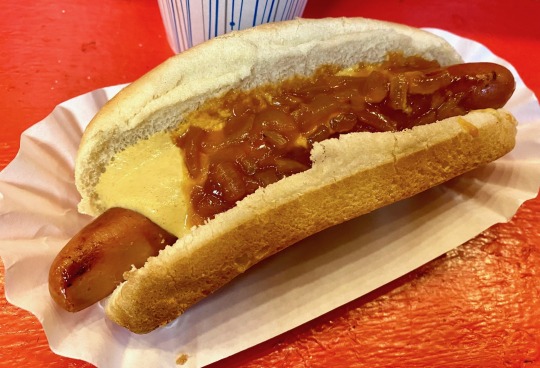
That picture says it all.
Not much more needs to be written about the magic of Gray’s Papaya; their last remaining stand is on the corner of Broadway and West 72nd St., and you can’t help but be pulled in by the glow of their lights and smell of grilling hot dogs if you’re in the area. Popped in last week after a night of drinking with some old friends...
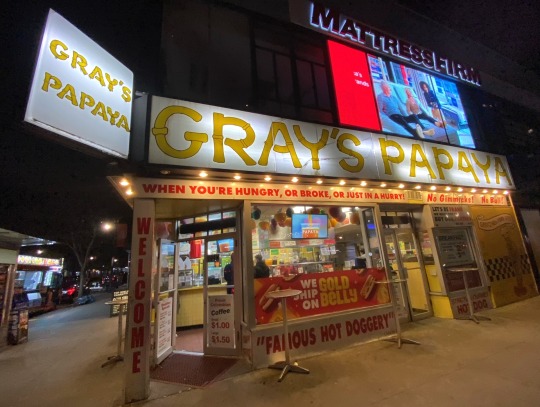
The one thing that has changed though is the prices. When I moved to NYC in 1996, their “Recession Special” was two dogs with the toppings of your choice and a drink for $1.99. Now? It was $4.95 for one dog and a drink...

As always, I went with their namesake, of course...

And as always, it was delicious! The frankfurter was perfectly grilled to get that snap you expect, slathered with onion sauce and a touch of mustard, both still free.
They do charge for other toppings now, though...
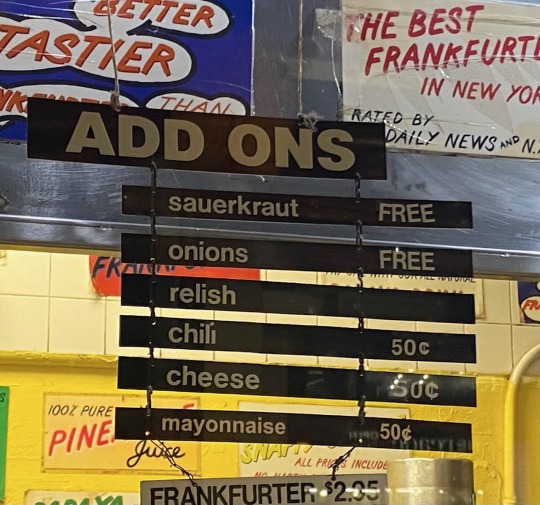
(Look, I love mayonnaise, but who puts it on a hot dog? And for fifty cents?!)
Three dogs and a drink will set you back $9.95, which isn’t too bad in the grand scheme of things here in Manhattan, but I can’t help but think back to “the good ‘ol days” whenever I eat here these days.
Putting current prices aside, Gray’s Papaya is a Big Apple institution and can’t be missed when you’re on the Upper West Side. A true taste of New York!
GRAY’S PAPAYA
2090 Broadway
NY, NY 10023
grayspapaya.nyc
#nyc#new york#new york city#new york eats#manhattan#big apple#hot dog#grill#grilled#frankfurter#classic#nyc classic#uws#gray's papaya#hot dog stand#new york institution#food#foodie#travel
225 notes
·
View notes